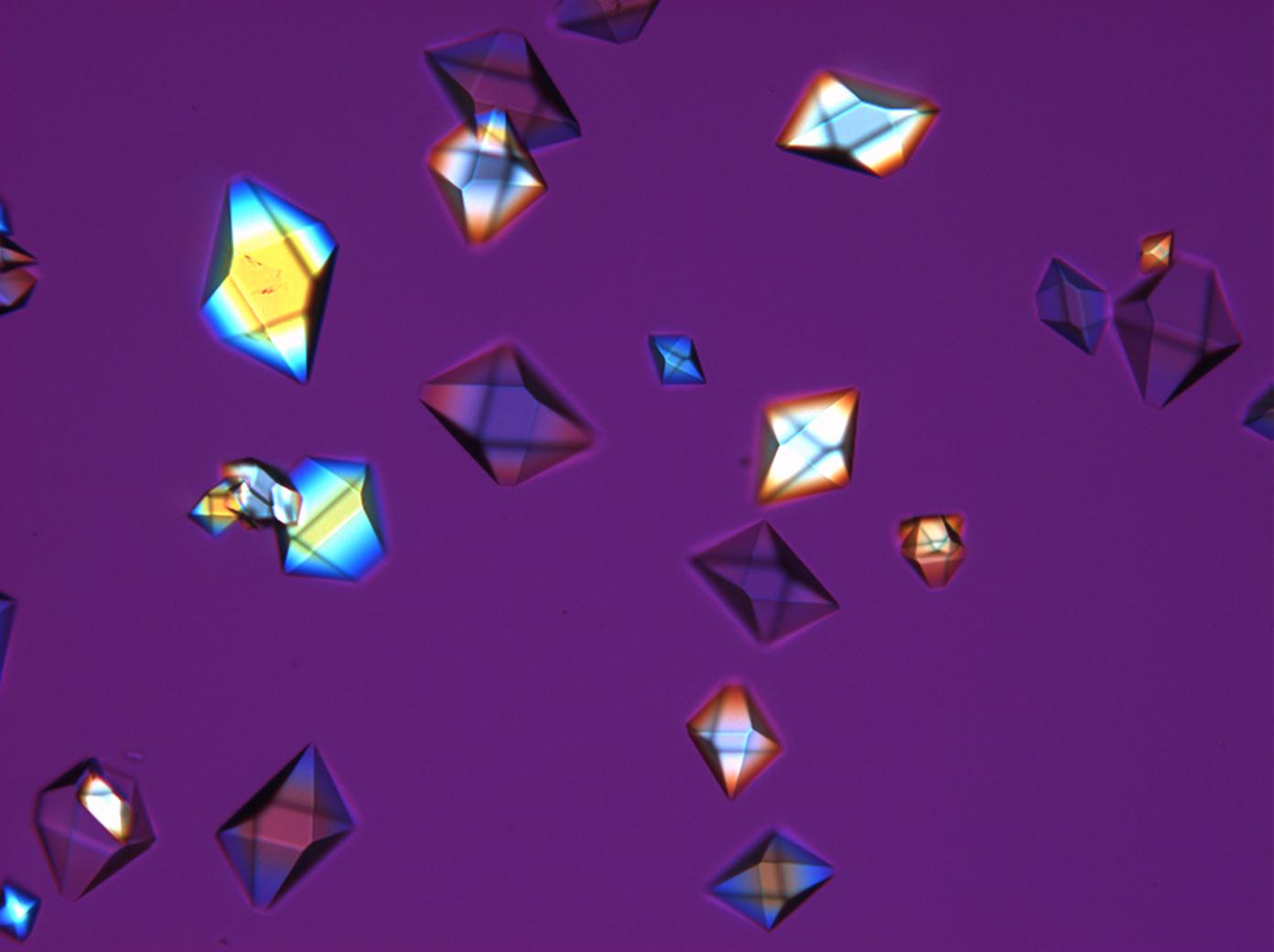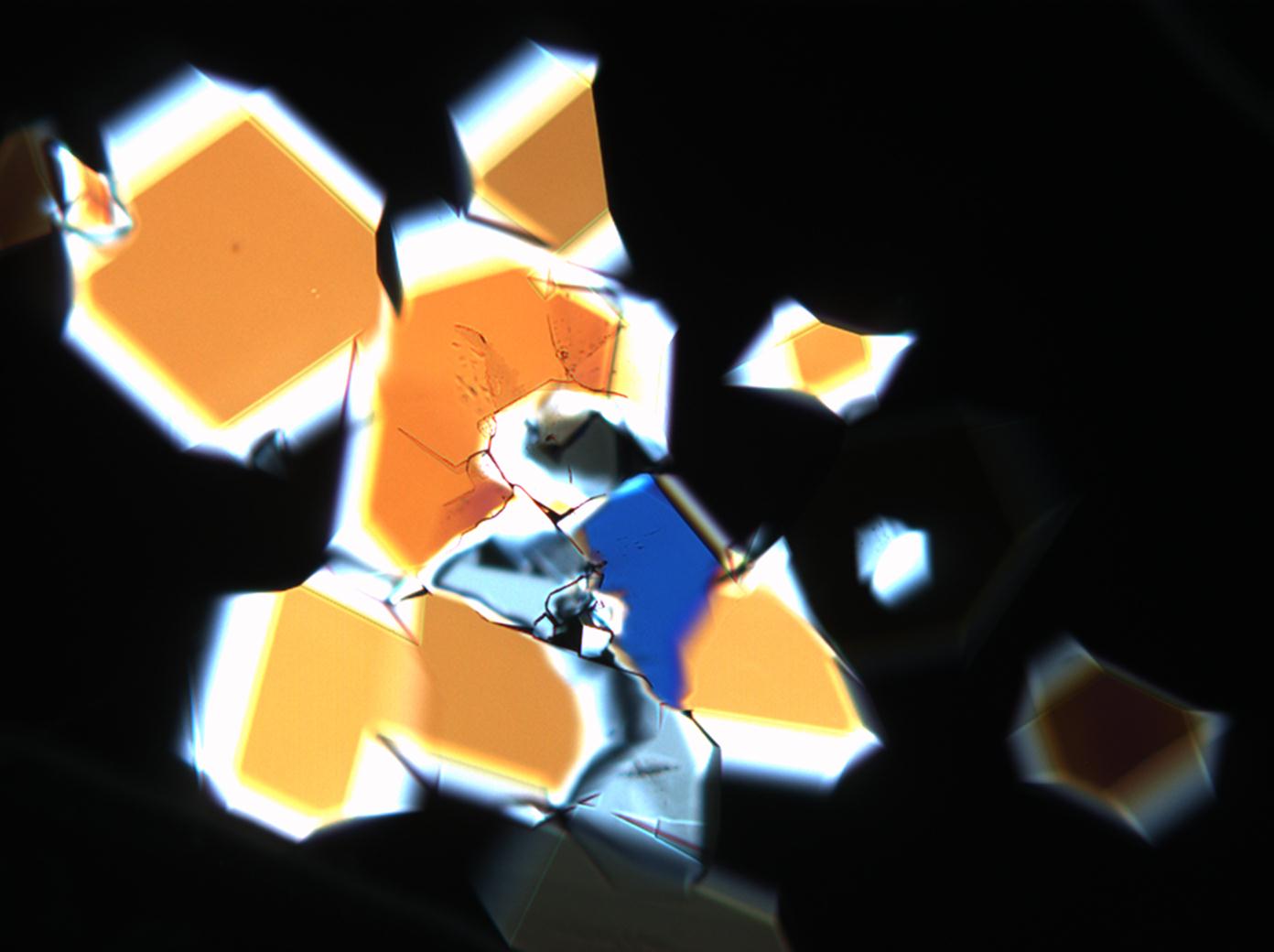Mirabilite: Difference between revisions
No edit summary |
No edit summary |
||
| Line 32: | Line 32: | ||
|Literature =<bib id="Robie.etal:1978"/> <bib id="Dana:1951"/> | |Literature =<bib id="Robie.etal:1978"/> <bib id="Dana:1951"/> | ||
}} | }} | ||
== Abstract == | == Abstract == | ||
< | Mirabilite which is the deacahydrate of sodium sulfate and its properties are presented. | ||
<!-- | |||
== Occurrence == | == Occurrence == | ||
| Line 46: | Line 46: | ||
--> | --> | ||
== Solubility properties == | == Solubility properties == | ||
[[file: | [[file:S Na2SO4.jpg|thumb|800px|left|'''Figure1''': Solubilities in the system Na<sub>2</sub>SO<sub>4</sub>-H<sub>2</sub>O in dependence of the temperature [according to <bib id="Steiger.etal:2008"/>].]] | ||
<br clear=all> | <br clear=all> | ||
The solubility of mirabilite is 1.35 mol/kg at 20 °C. The solubility shows a high temperature dependence, it decreases with decreasing temperatures and it increases at higher temperatures. Above 32.4 °C mirabilite is unstable, so [[thenardite]] is the stable phase at higher temperatures. | |||
see [[Sodium sulfate]] | see [[Sodium sulfate]] | ||
| Line 55: | Line 57: | ||
== Hygroscopicity == | == Hygroscopicity == | ||
[[file: | [[file:D Na2SO4e.jpg|thumb|800px|right|'''Figure 2''': Deliquescence behaviour in the system Na<sub>2</sub>SO<sub>4</sub>-H<sub>2</sub>O and equilibrium humbidities for the transformation thenardite/mirabilite, according to <bib id="Steiger.etal:2008"/>]] | ||
Figure 2 illustrates the influence of temperature on the deliquescence | Figure 2 illustrates the influence of temperature on the deliquescence humidities of mirabilite and on the other phases of sodium sulfate. It is notable that for mirabilite and [[thenardite]] the graphs of the deliquescence humidities run in opposite directions. Unlike the deliquescence humidity of theardite those of mirabilite decreases with increasing temperature.<br> | ||
The deliquescence humidity of mirabilite lies always above 87 % in its stable temperature range (table 1). See also [[sodium sulfate]] | |||
<br clear=all> | |||
{|border="2" cellspacing="0" cellpadding="4" width="52%" align="left" class="wikitable" | |||
|+''Table 1: The temperature dependence of the deliquescence humidities of mirabilite <bib id="Steiger.etal:2008"/>'' | |||
|- | |||
|bgcolor = "#F0F0F0" align=center| 0°C | |||
|bgcolor = "#F0F0F0" align=center| 10°C | |||
|bgcolor = "#F0F0F0" align=center| 20°C | |||
|bgcolor = "#F0F0F0" align=center| 30°C | |||
|- | |||
|bgcolor = "#FFFFEO" align=center| 98.8%r.h. | |||
|bgcolor = "#FFFFEO" align=center| 97.8%r.h. | |||
|bgcolor = "#FFFFEO" align=center| 95.6%r.h. | |||
|bgcolor = "#FFFFEO" align=center| 90.1%r.h. | |||
|} | |||
<br clear=all> | |||
The presence of other ions, as in the case of salt mixtures, can significantly alter the equilibrium humidity parameters, i.e., the temperature and humidity conditions which initiate phase changes. Table | The presence of other ions, as in the case of salt mixtures, can significantly alter the equilibrium humidity parameters, i.e., the temperature and humidity conditions which initiate phase changes. Table 2 lists the experimentally determined equilibrium humidity of different salt mixtures. This shows that the equilibrium humidity of pure mirabilite is higher than that of the other salts. | ||
<br clear="all"> | <br clear="all"> | ||
{|border="2" cellspacing="0" cellpadding="4" width="52%" align="left" class="wikitable sortable" | {|border="2" cellspacing="0" cellpadding="4" width="52%" align="left" class="wikitable sortable" | ||
|+'' | |+''Table 2: Equilibrium humidity data of saturated salt mixture solutions (mixing ratio: Saturated solution A/saturated solution = 1:1) <bib id="Vogt.etal:1993"/>.'' | ||
|- | |- | ||
|bgcolor = "#F0F0F0"| | |bgcolor = "#F0F0F0"| | ||
| Line 76: | Line 94: | ||
|} | |} | ||
<br clear="all"> | <br clear="all"> | ||
<!-- | |||
'''Hygroscopicity ''' | '''Hygroscopicity ''' | ||
| Line 82: | Line 101: | ||
<br clear="all"> | <br clear="all"> | ||
{|border="2" cellspacing="0" cellpadding="4" width="52%" align="left" class="wikitable sortable" | {|border="2" cellspacing="0" cellpadding="4" width="52%" align="left" class="wikitable sortable" | ||
|+''Table | |+''Table 3: Moisture sorption in M.% after 56 days storage of sodium sulfate <bib id="Vogt.etal:1993"/>'' | ||
|- | |- | ||
|bgcolor = "#F0F0F0"| '''storage relative RH''' | |bgcolor = "#F0F0F0"| '''storage relative RH''' | ||
| Line 100: | Line 119: | ||
|} | |} | ||
<br clear="all"> | <br clear="all"> | ||
--> | |||
== Crystallization pressure == | == Crystallization pressure == | ||
The crystallization of mirabilite from aqueous solution results in a crystallization pressure of 7.2-8.3 N/mm<sup>2</sup>. | The crystallization of mirabilite from aqueous solution results in a crystallization pressure of 7.2-8.3 N/mm<sup>2</sup>. | ||
== Hydration behavior == | == Hydration behavior == | ||
[[file:Mirabilit Thenardit.ogg|thumb|400px|right|Conversion of mirabilite (?) into thenardite]] | |||
The Na<sub>2</sub>SO<sub>4</sub> – H<sub>2</sub>O system: | |||
The only stable forms of sodium sulfate are the decahydrate ([[Mirabilite|mirabilite]]) and the anhydrite (thenardite). The generation of mirabilite by recrystallization of the salt from an aqueous supersaturated solution occurs at 32.4°C. In particular, the transition from thenardite to mirabilite and the incorporation of 10 water molecules in the crystal lattice causes a volume expansion of 320%. This transition happens at a relatively low temperature (32-35°C), the damage caused by this salt is highly dependent on the temperature and thus on the environment. This temperature range is given as a guide, because this transition could happen for example at 25°C at 80% relative humidity, or even at 0°C at 60.7% relative humidity [information from Gmelin]. Due to this strong dependence on the environmental parameters, an estimate of the damage caused on buildings by crystallization and hydration of sodium sulfate are very difficult to obtain. | |||
== Analytical evidence == | == Analytical evidence == | ||
Revision as of 09:06, 7 May 2015
Authors: Hans-Jürgen Schwarz, Nils Mainusch
English version by Christa Gerdwilker
back to Sulfate
| Mirabilite[1][2] | |
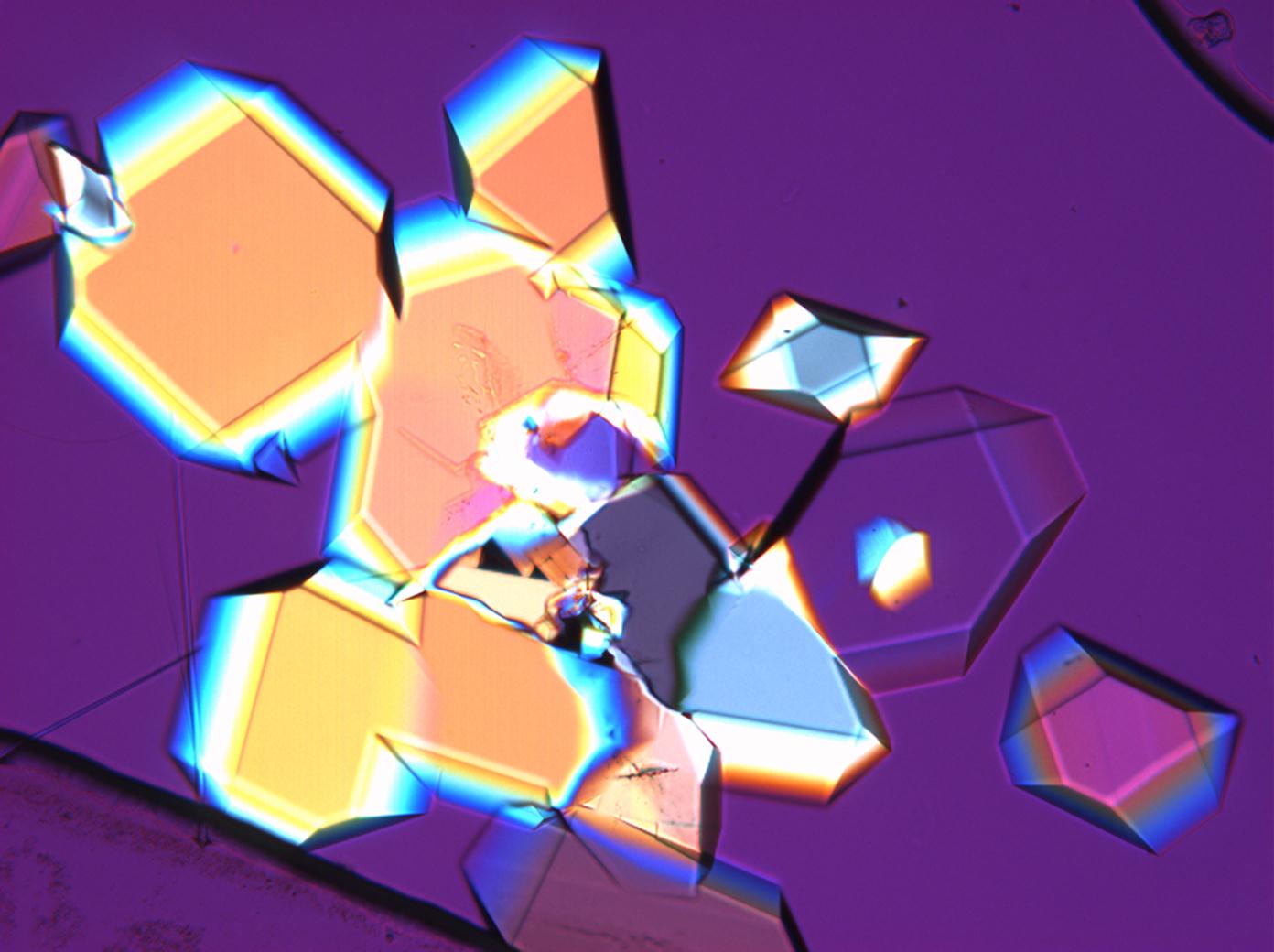
| |
| Mineralogical name | Mirabilite |
| Chemical name | Sodium sulfate decahydrate |
| Trivial name | Glauber salt, Reussin, Soda Sulfate |
| Chemical formula | Na2SO4•10H2O |
| Other forms | Na2SO4•7H2O (sodium sulfate heptahydrate) |
| Crystal system | monoclinic |
| Crystal structure | |
| Deliquescence humidity 20°C | 95.6 % |
| Solubility (g/l) at 20°C | 1.353 mol/kg |
| Density (g/cm³) | 1.466 g/cm³ |
| Molar volume | 219.8 cm3/mol |
| Molar weight | 322.19 g/mol |
| Transparency | transparent to opaque |
| Cleavage | perfect |
| Crystal habit | |
| Twinning | |
| Phase transition | |
| Chemical behavior | |
| Comments | soluble in water and glycerin, insoluble in pure alcohol easily loses some water, converts to thenardite at 32°C abnormal blue or brown interference colors |
| Crystal Optics | |
| Refractive Indices | nx = 1.394 ny = 1.396 nz = 1.398 |
| Birefringence | Δ = 0.004 |
| Optical Orientation | negative |
| Pleochroism | |
| Dispersion | 76° |
| Used Literature | |
| [Robie.etal:1978]Title: Thermodynamic properties of minerals and related substances at 298.15 K and 1 bar pressure and higher temperatures Author: Robie R.A., Hemingway B.S.; Fisher J.A.  [Dana:1951]Title: Dana's System of Mineralogy [Dana:1951]Title: Dana's System of MineralogyAuthor: Dana J.D. 
| |
Abstract[edit]
Mirabilite which is the deacahydrate of sodium sulfate and its properties are presented.
Solubility properties[edit]
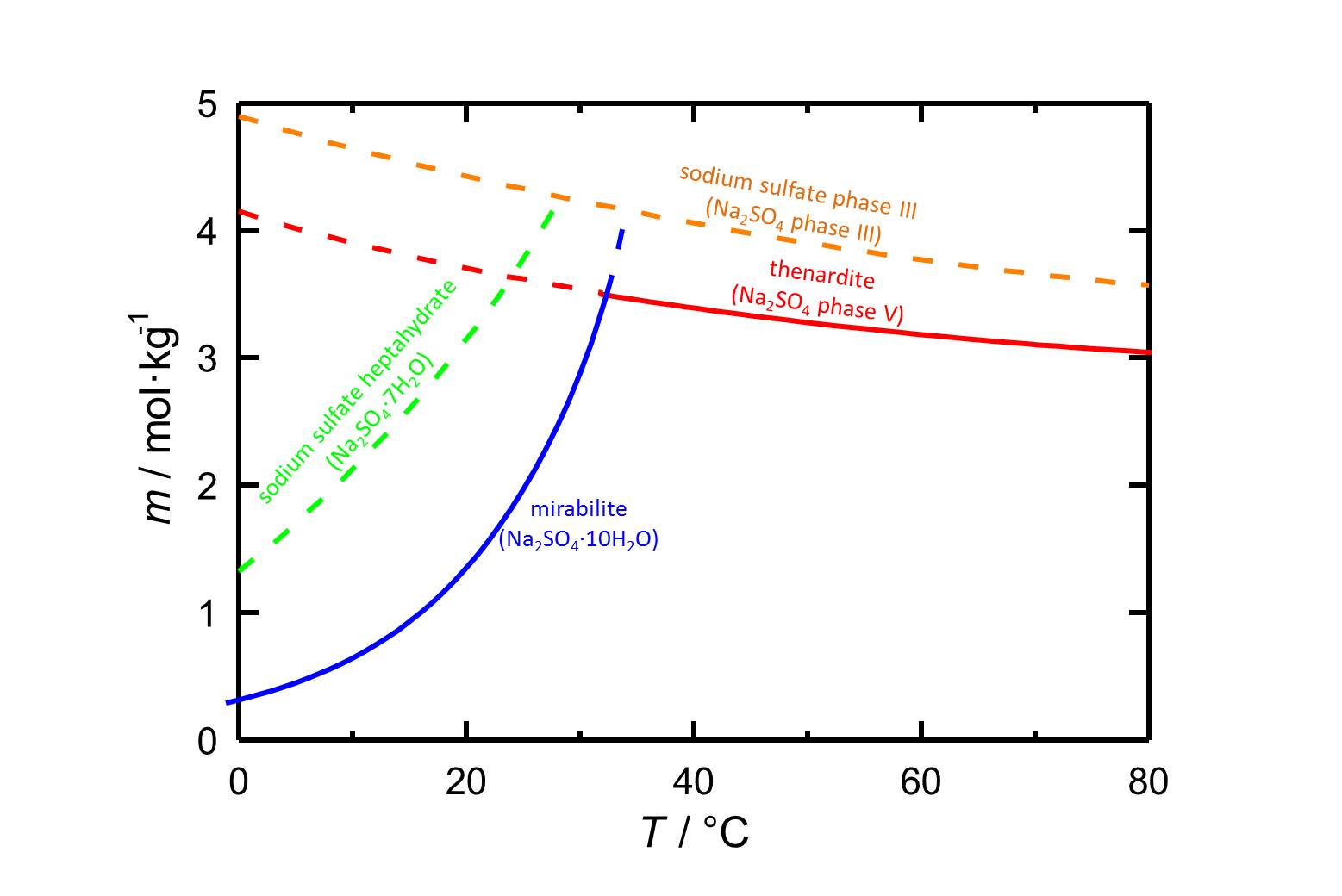
Author: Steiger, Michael; Asmussen, Sönke
 ].
].
The solubility of mirabilite is 1.35 mol/kg at 20 °C. The solubility shows a high temperature dependence, it decreases with decreasing temperatures and it increases at higher temperatures. Above 32.4 °C mirabilite is unstable, so thenardite is the stable phase at higher temperatures.
see Sodium sulfate
Hygroscopicity[edit]
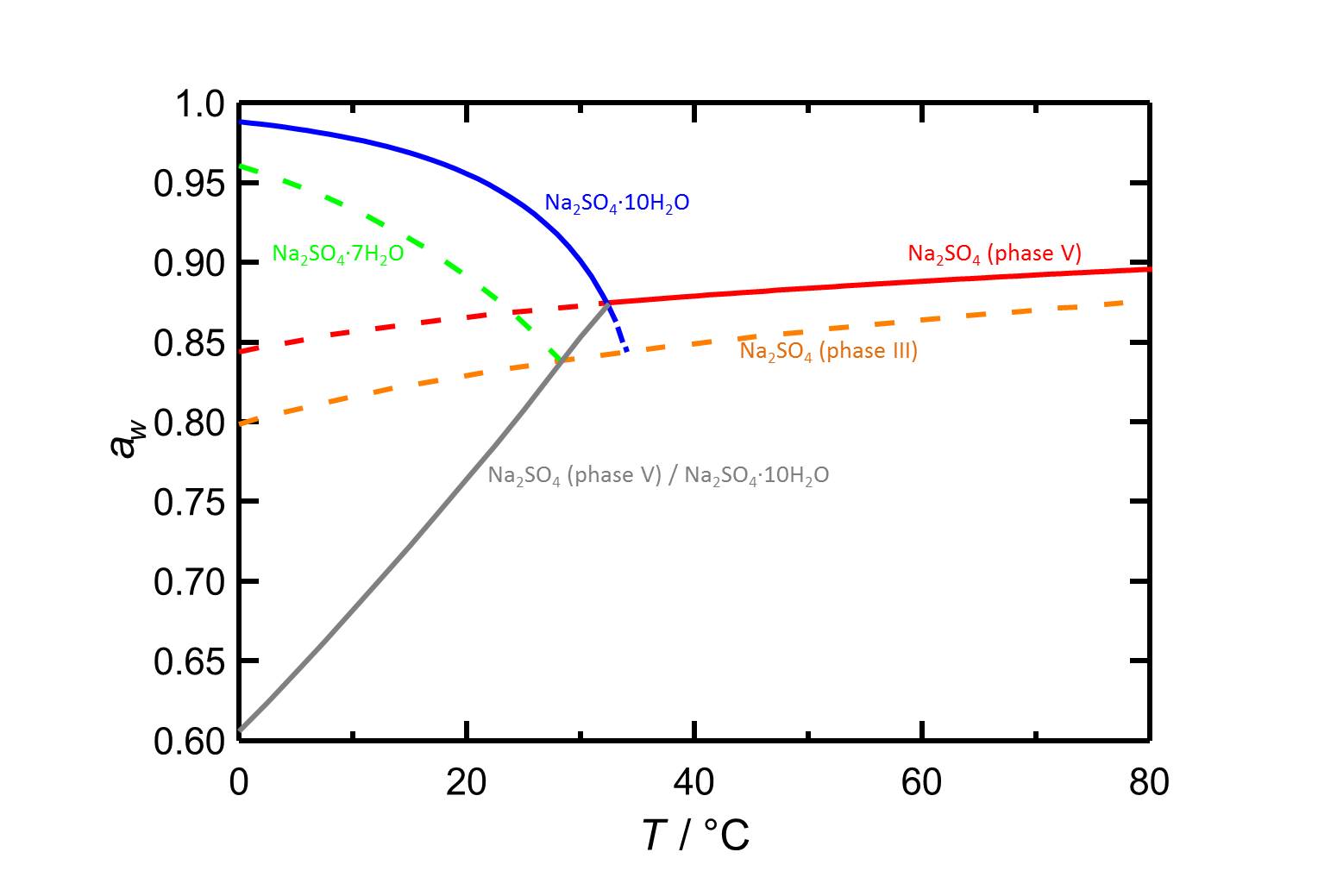
Author: Steiger, Michael; Asmussen, Sönke

Figure 2 illustrates the influence of temperature on the deliquescence humidities of mirabilite and on the other phases of sodium sulfate. It is notable that for mirabilite and thenardite the graphs of the deliquescence humidities run in opposite directions. Unlike the deliquescence humidity of theardite those of mirabilite decreases with increasing temperature.
The deliquescence humidity of mirabilite lies always above 87 % in its stable temperature range (table 1). See also sodium sulfate
| 0°C | 10°C | 20°C | 30°C |
| 98.8%r.h. | 97.8%r.h. | 95.6%r.h. | 90.1%r.h. |
The presence of other ions, as in the case of salt mixtures, can significantly alter the equilibrium humidity parameters, i.e., the temperature and humidity conditions which initiate phase changes. Table 2 lists the experimentally determined equilibrium humidity of different salt mixtures. This shows that the equilibrium humidity of pure mirabilite is higher than that of the other salts.
| MgSO4 | Ca(NO3)2 | KNO3 | |
| Na2SO4 • 10H2O | 87(21°C) | 74 (21°C) | 81(21°C) |
Crystallization pressure[edit]
The crystallization of mirabilite from aqueous solution results in a crystallization pressure of 7.2-8.3 N/mm2.
Hydration behavior[edit]
The Na2SO4 – H2O system:
The only stable forms of sodium sulfate are the decahydrate (mirabilite) and the anhydrite (thenardite). The generation of mirabilite by recrystallization of the salt from an aqueous supersaturated solution occurs at 32.4°C. In particular, the transition from thenardite to mirabilite and the incorporation of 10 water molecules in the crystal lattice causes a volume expansion of 320%. This transition happens at a relatively low temperature (32-35°C), the damage caused by this salt is highly dependent on the temperature and thus on the environment. This temperature range is given as a guide, because this transition could happen for example at 25°C at 80% relative humidity, or even at 0°C at 60.7% relative humidity [information from Gmelin]. Due to this strong dependence on the environmental parameters, an estimate of the damage caused on buildings by crystallization and hydration of sodium sulfate are very difficult to obtain.
Analytical evidence[edit]
Microscopy
[edit]
Laboratory analysis:
Observations of the solubility behavior through the microscope allows to verify the high water solubility of sodium sulfate and its insolubility in ethanol. Thenardite and mirabilite do not have morphological characteristics to aid their identification during simple recrystallization experiments. Instead, a broad range of different forms can be observed.
Refractive indices: nx = 1,395; ny =1.396-1.410; nz =1.398-1.419
Birefringence: Δ = 0.04-0,023
Crystal classe: monocline
Under the polarizing microscope:
The crystallization water content of the sample or its re-crystallized form depends on the ambient RH and temperature levels. In dry air (lower than 80% RH at room temperature) mirabilite loses its water of crystallization content and changes to thenardite. This process can be observed during recrystallization under the microscope. Mirabilite has characteristic abnormal interference colors which weaken during water loss and the formation of thenardite.
Differentiation from different salts:
Generally, the differentiation of certain sulfates (listed below and including thenardite) without the microchemical determination of the cations is problematic as their refractive indices are close to each other and all salts display a slight double refraction. The use of an immersion material with a nD-value of 1.48 is helpful and allows the differentiation of salts within this group. Additionally, the properties listed below can also be taken into consideration. Thenardite can be determined indirectly by the appearance of mirabilite during recrystallization to the hydrated form.
| Salt phase | Characteristics |
| Boussingaultite (NH4)2Mg(SO)4 • 6H20 | no abnormal interference colors/oblique extinction |
| Picromerite K2Mg(SO4)2 • 6H20 | no abnormal interference colors/oblique extinction |
| Bloedite Na2Mg(SO4)2 • 6H20 | all indices >1.48 / no abnormal interference colors/oblique extinction / negative optical orientation |
| Glaserite K3Na(SO4)2 | all indices >1.48 / no abnormal interference colors/oblique extinction |
| Arcanite K2SO4 | all indices >1.48 / no abnormal interference colors |
| Dashkovaite Mg(HCO2)2 • 2H2O | relatively high birefringence/ no abnormal interference colors/oblique extinction |
Mixtures:
Mixed systems Na+– Ca2+– SO4 2-: Due to its lower solubility, gypsum precipitates first during re-crystallization. The characteristic needle shaped gypsum crystals are the first to form while sodium sulfate precipitates later, the crystal growth is noticeably faster but the morphology is non-specific.
Mixed system Na+– SO4 2-– Cl-: The precipitation of both types of particles begins practically at the same time. Halite has a characteristic morphology whereas sodium sulfate occurs in extremely varying forms.
Under the polarizing microscope[edit]
- Sodium sulfate crystallization between two glass slides
Weblinks
[edit]
- ↑ http://webmineral.com/data/Mirabilite.shtml accessed 29/07/2010
- ↑ http://www.mindat.org/min-2725.html accessed 29/07/2010
Literatur[edit]
| [Dana:1951] | Dana E.S. (eds.) Dana J.D. (1951): Dana's System of Mineralogy, 7, Wiley & Sons |  |
| [Robie.etal:1978] | Robie R.A., Hemingway B.S.; Fisher J.A. (1978): Thermodynamic properties of minerals and related substances at 298.15 K and 1 bar pressure and higher temperatures. In: U.S. Geol. Surv. Bull, 1452 () |  |
| [Steiger.etal:2008] | Steiger, Michael; Asmussen, Sönke (2008): Crystallization of sodium sulfate phases in porous materials: The phase diagram Na2SO4–H2O and the generation of stress. In: Geochimica et Cosmochimica Acta, 72 (17), 4291-4306, Url |  |
| [Vogt.etal:1993] | Vogt, R.; Goretzki, Lothar (1993): Der Einfluss hygroskopischer Salze auf die Gleichgewichtsfeuchte und Trocknung anorganischer Baustoffe, unveröffentlichter Bericht. |  |
